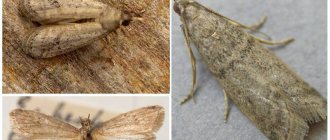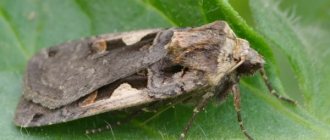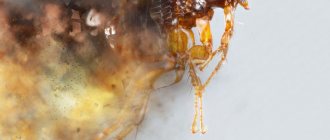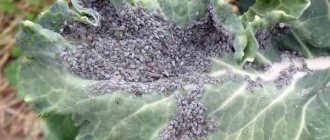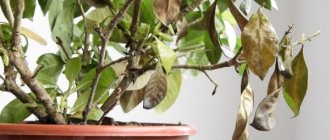Aphids on tomatoes
Physical methods of controlling aphids
Anti-aphid remedies
Chemicals for killing insects
Although tomato tops are one way to control aphids and other pests, the bushes themselves can also be affected. Moreover, most often small insects do not touch the fruits, but settle on tender young leaves, which causes great harm to the plant, sucking out the juices and contributing to the disease and death of a valuable garden crop. Therefore, the story about how to fight aphids on tomatoes will be relevant and useful for many gardeners.
Types of aphids that live on tomatoes
Many people know what aphids look like on garden and vegetable crops. These are small insects 2-3 mm in size that parasitize whole colonies on the underside of leaves and on young shoots of plants. They settle both on greenhouse tomatoes and in open ground, attacking both seedlings and adult bushes.
In the garden you can find different types of these pests: white and black, green, melon and red aphids. There are also insects with and without wings.
The most common types of aphids found on tomatoes are:
- White or root - hatches from eggs overwintering in the ground and settles near the soil surface, which makes it difficult to detect. It moves quickly and gradually chews through the base of plant stems. White aphids that have settled on tomato seedlings can completely block the access to moisture, inhibiting the development of young bushes.
- Potato aphids are red or green insects up to 4 mm in size that attack greenhouse and ground tomatoes.
- Melon aphids are very small pests measuring 1-2 mm in various shades of green. Awakening in the spring and early summer in the greenhouse, the larvae begin to actively develop, gradually become adults, and then fly out into the open air in July-August; winged females are black and green in color.
- Peach (or greenhouse) - overwinters at the bases of the buds of peach trees; during spring reproduction, it often moves to tomatoes and other garden crops.
Aphids on tomatoes
On a note!
A winged aphid is a fertilized female that selects a garden or garden plant, settles on it and, laying eggs, creates a colony of parasites.
Aphids are very often found on tomatoes in a greenhouse, where there are the most favorable conditions of humidity and heat for its development and reproduction. Therefore, any owner who detects even a small amount of such a pest on his seedlings or adult plants needs to choose as quickly as possible how to treat tomatoes against aphids before they cause much damage.
Why is this pest dangerous?
In Russia and other countries, aphids are found almost everywhere.
Aphids pose a danger to plants both in open ground and in greenhouses.
Harm from aphids is manifested in the following:
- The pest feeds on cell juices, which is why the bush begins to lose leaves, shed flowers and ovaries.
- Aphids secrete toxic substances that destroy plant tissue. If you do nothing, the plant may die.
- In addition, insects leave their metabolic products on the surface of the leaves - sticky, sweetish secretions. Because of this, plants cannot breathe, and the surface of the foliage becomes overgrown with adhering dirt.
When the first signs of aphids appear, you need to immediately begin fighting the insect. Otherwise, you may lose a significant part or even the entire harvest. The main danger is the exceptional fertility of aphids. During the season it gives up to 50 generations, among which there are wingless and winged forms.
Basically, insects attack not leaves, but flowers and ovaries - tough foliage is too tough for this pest. At the end of the season, aphids lay eggs in the buds and directly on the soil. Therefore, it is advisable to carry out the first preventive treatment of bushes in the spring - a few days after transplantation or immediately after transferring them to open ground.
Signs of aphid damage to tomatoes
Signs of damage by small pests on tomatoes and cucumbers:
- leaves, ovaries and young shoots first turn yellow and curl, and then dry out and crumble;
- on the fruits and tops you can see a sticky coating secreted by insects, called sweet honeydew; ants are very fond of it;
- the bushes stop developing and begin to hurt.
Aphids usually do not touch fruits that have already set on adult plants, but young shoots or seedlings can become sick and die, since such insects are also carriers of various infections and viruses. Therefore, the optimal time to get rid of aphids on tomatoes is the period before flowering.
Methods for controlling aphids
Physical methods of controlling aphids Gardeners have accumulated a wealth of experience in combating pests over many years, and most often these methods depend on the growing season and the season when aphids are detected.
In the initial stage of infection, it is recommended to use traditional methods, and in case of severe damage, use insecticidal preparations. Physical methods of struggle:
- You can remove aphids manually by pinching and squashing them between the affected leaves; it is also recommended to use a toothpick.
- It is better to remove green parts that are heavily damaged and deformed, especially the lower shoots and stems.
- The easiest way is to wash off the parasites with a stream of water from a hose or sprayer; it is best to use it daily until the insects are completely gone.
- Predatory insects can significantly reduce the number of aphids on tomatoes: ladybugs, sand wasps and lacewings, as well as birds.
Prevention measures
To reduce the likelihood of infestation with black aphids or other varieties, preventive measures are necessary.
- Pay attention to large concentrations of garden ants in your garden or vegetable garden. Their anthills may contain aphid eggs. To effectively combat these pests, it is recommended to first remove the ants from your area.
- Even in the early stages of infection, take comprehensive measures. A female can lay more than 2 thousand eggs in a month, which leads to rapid proliferation of the colony. Even at the initial stage of infection, it is better to use several control methods.
- Plant repellent plants and attract ladybugs to your area.
Application of traditional methods
Remedies against aphids
If tomatoes are attacked by aphids, then various folk remedies that can completely destroy the parasites are excellent in the initial stage of infection. All of the following components are available in every household and can be easily prepared at home:
- Composition of 400 g of vegetable oil and 2 tbsp. Spray the tomatoes with 1 liter of tar or laundry soap per 1 liter of water, preferably several times until the insects disappear completely.
- The use of herbal decoctions and tinctures: celandine, wormwood, yarrow and others, which have a bitter taste and a pungent odor. Usually add 1 liter of prepared infusion and 40 g of soap to the bucket for better adhesion.
- An ash-soap solution is prepared from 1 tbsp. ash, 20 g of laundry soap per 10 l.
- Using an infusion of shag or crushed tobacco will help destroy aphids, for which 500 g of powder is poured into 1 liter of boiling water and kept on low heat for 30 minutes, filtered. Before treatment, the solution must be diluted in 10 liters of liquid.
- One of the proven methods is baking soda for aphids in the amount of 75 g of soda per bucket; the mixture can be used to treat both garden crops and fruit trees;
- Ammonia also helps in the fight against aphids, which has an irritating effect not only on their respiratory system with its pungent odor, but also causes a burn to the digestive organs, leading to paralysis and death of insects. To prepare the solution, add 2 tbsp to the bucket. l ammonia and 1 tbsp. l soap or detergent.
How to process tomatoes?
To quickly and permanently get rid of pests, you need to know how to properly deal with them. The following methods are distinguished:
- chemical;
- physical;
- using folk remedies.
Did you know? The houses of aphids are called galls. When they are damaged, insects release liquid to repair their homes, while losing weight and risking death from exhaustion!
Physical methods are the least effective, and manual collection or hose-off are time-consuming. But people often resort to them because they believe that if there are tomatoes themselves, then they should not be processed in any way.
When the first signs of damage appear, measures are taken immediately, since insects spread quickly, especially during fruiting of the vegetable, since during this period the tomato bush is saturated with a large amount of juice.
Chemicals
This is a quick and easy way to save a plant, since the aphid habitat is treated just once with the product, and it disappears.
Important! When purchasing chemicals against aphids, study their effect on human health to avoid poisoning or allergies! Preparations for controlling aphids:
- "Karbofos" . It is necessary to spray before flowering, since harmful substances are released within two weeks and then disintegrate. Works only on adults, not eggs. Dilute 30 grams per 15 liters of water, spray on areas where insects accumulate.
- Bleaching powder . You need to dilute 2 tablespoons with 15 liters of water, then treat the leaves. A universal remedy for both the plant itself and the soil.
- "Trichopolus" . Use according to the scheme: 20 tablets per 10 liters of water. This solution is safe for both tomatoes and human health. The drug is used to treat diseases, but can also be used as a chemical against insects.
Pay attention to the instructions for the drug you are using. This will not only help the plant get rid of pests, but its fruits will also be safe for humans to eat.
Traditional methods
If chemicals are not suitable, traditional methods are used, which are also effective. But you need to know how to treat tomatoes so that the plant does not rot and develops well.
The following methods are used:
- Using soda . To prepare the solution, mix three tablespoons of baking soda in a bucket of water, then treat the affected areas. It must be taken into account that soda in large quantities affects the composition of the soil, and as a result the plant develops more slowly.
- Using ammonia . To do this, 2 tablespoons of ammonia are mixed with 10 liters of water, after which for 10 days with a break of 2-3 days you need to spray the plant along the entire perimeter and the plants adjacent to it for prevention.
Wood ash is also used, but it is effective if the aphids are close to the ground. Find out also how to get rid of midges on tomatoes.
Ash-soap solutions
Soap (laundry or liquid) works well against aphids and other pests. Cosmetic, children's, fruit, etc. It's better not to take it.
To obtain a solution (per 10 liters of water) you need to take:
- 10-15 tablespoons of laundry soap.
- 5-8 tablespoons of liquid soap.
- 5 tablespoons of tar soap.
The soap is taken not in the form of a piece, but in shavings, which can be easily obtained using a regular grater. It is better to dissolve in warm water - then the process will go much faster.
To destroy aphids, ash obtained from burning firewood, plywood, dies, etc. is also used. Take 1.5 cups of ash (250-300 g), dissolve in 10 liters of water and cook after boiling for half an hour. Be sure to add 2 tablespoons of soap shavings to the solution, because otherwise the liquid will quickly be washed off from the surface of the tomato leaves.
Coca Cola
The simplest folk remedy. It is enough to purchase a bottle of this drink, install a sprayer and treat the affected bushes.
Mustard
100 g of mustard powder is diluted in 3 liters of hot water, then infused for 3-4 hours. After sediment appears at the bottom, 4 tbsp is added. l. crushed soap, the same amount of vegetable oil and 5 liters of water. The prepared solution is poured into a spray bottle and processed.
Vodka
You just need to buy vodka, install a sprayer on the bottle and spray the infected plants. You can use diluted alcohol.
Ammonia
4 tbsp is diluted in a bucket of water. l. ammonia and the prepared solution are sprayed every 3 days. The procedure should be repeated no more than 4 times.
Ammonia against aphids - the best effective recipes
Baking soda
A simple recipe including 20 liters of water and 3-4 tbsp. l. soda You can spray the affected tomatoes with the prepared solution.
It is impossible to increase the concentration of soda - this can lead to the growth of tomatoes.
Green soap
A more natural, but no less effective remedy than laundry soap. You will need to take 400 ml of this soap per bucket of water, stir thoroughly and start spraying.
Vinegar
A solution prepared from 1 liter of water, 1 tbsp. has worked well. l. vinegar and 10 drops of liquid soap or detergent.
Birch tar
The tar itself is not capable of poisoning aphids, however, its pungent odor repels insect pests well. A solution is prepared from this substance, consisting of 15 g of the main component, 50 g of tar soap, and 10 liters of water.
Boric acid
You can kill aphids on tomatoes using a boric acid solution. To prepare it you will need to take 2 g of acid per 1 liter of water.
A more concentrated solution can harm the culture.
Milk with iodine
You can remove the pest using iodine and milk. 0.5 ml of iodine and 1 liter of water are added to heated 100 ml of milk. The finished composition is used for spraying.
Flea shampoo
You can use a budget flea shampoo designed for cats and dogs. You will need 1-2 tbsp per bucket of water. l. this remedy.
Herbal infusions
Another popular group of aphid remedies are herbal water infusions.
They must be used with greater caution, since in high concentrations they can cause burns on tomato leaves. In addition, some plants are poisonous and can cause an allergic reaction in humans.
According to the experience of summer residents, the following infusions are the most effective and at the same time safe (in all recipes, the resulting solution must be brought to 10 liters of water):
- Onion - several onions (200 g) with peels are placed in 1 liter of water for several hours, then a teaspoon of laundry soap is added and filtered.
- Garlic - several heads of garlic (200) g are crushed together with the husk, then put in 1 liter of water and left for a week, then filtered.
- Potato : take 1 kg of tops, chop and put in 10 liters of water for 4 hours, then filter. If the tops are dry, they can be taken in the amount of 800 g per 10 liters.
- Citrus : take fresh peels of any citrus (100 g is enough) and pour a liter of warm water, leave for 3 days.
- Dandelion : Dandelions grow in almost every area, so you can easily collect leaves (400 g) and roots (200 g), chop them and leave in a bucket of water for 4 hours.
- Tobacco - dry tobacco (1 cup - 200 g) dissolved in 5 liters. Then let it brew for 2 days and filter.
- Chamomile - 100 g of pharmaceutical chamomile is poured overnight with a liter of water, then filtered. Grind the laundry soap, take 3 large spoons of shavings, mix thoroughly.
- Sorrel - take the roots of horse sorrel in an amount of 400 g, pour in 2-3 liters of hot water and leave for a day, then filter.
- Pepper : buy 100 g of chili pepper and infuse 1-2 days in 1 liter of water. The solution must be diluted to 10 liters - otherwise the tomatoes will get burned.
- Pine : this remedy is suitable if pine grows on the site. It is necessary to collect 1 kg of needles and leave for a week in 4 d water, stirring every day.
To prepare aphid infusions, only healthy plants are taken - without damage or signs of disease. Otherwise the effect may be the opposite
Herbal decoctions
Decoctions are a little more difficult to obtain, but they fight aphids even better, since the beneficial substances dissolve in larger quantities in boiling water.
To process tomatoes you can use the following recipes:
- Tobacco decoction : dry 200 g of tobacco leaves, chop them, leave for 1 day in 5 liters, add another 5 liters and cook over low heat for 2 hours after boiling.
- Yarrow decoction : take 1 kg of dry herb, pour 2 liters and boil in a water bath for half an hour. Then you need to dilute 10 liters and let it stand in a dark place for 2-3 days.
- Pepper decoction : buy 100 g of chili pepper, chop and boil in 1 liter of water (1 hour after boiling over low heat). Then bring to 10 liters, add 2 tablespoons of soap shavings.
- Decoction of celandine : collect 400 g of the green part of the plant, chop it, add 1 liter of water and leave for 2 days. Then bring to a boil and cook for half an hour, filter and bring to 10 liters of water.
Mechanical
You can get rid of aphids on tomatoes in a greenhouse and open ground mechanically. This method includes manual collection of insects, removal of foliage affected by parasites, followed by burning them, and washing the bushes with water from a hose.
Such manipulations are performed daily until the harmful insects are completely eliminated.
Biological
To destroy pest colonies, you can resort to one of the safest methods - biological. At the same time, natural enemies of parasites are lured into the garden plot. These can be flies, wasps and lacewings. Insects eat aphids and their larvae with great pleasure. In just a few days, this will solve the problem.
Birds will also help in pest control. In order for them to fly to the site, immediately after planting, you need to install drinking bowls in the garden.
Chemicals
It is best to combat aphids with chemicals before the onset of the tomato flowering period, so that harmful substances do not enter the fruits. To do this, you can use various drugs against aphids and other pests:
- Biotlin is a drug that is recommended for use in greenhouses; it destroys adult pests and inhibits the development of aphid larvae. The solution is prepared by adding 5 ml of product per bucket, which will allow you to spray tomatoes over an area of up to 30 square meters. m.
- Spark is an insecticide that will help not only poison aphids and other types of insects, but also feed plants with potassium supplements and anti-stress additives.
- Karbofos is an effective remedy for aphids, it penetrates the insect body through the shell, maintaining a toxic effect for 7-10 days, and has low toxicity for humans.
- Aktara, Tanrek - poison aphids after they eat the green parts of treated plants; treatment of tomatoes against aphids is carried out according to the instructions in a certain dosage; it should be taken into account that the substance can accumulate in the fruits.
- Biological product Fitoverm, which has a wide spectrum of action.
- Chloride of lime - used for spraying the lower part of leaves and stems, has a positive effect on the soil and helps in the fight against not only aphids and other pests, but also diseases of garden crops.
Important!
It is necessary to treat and spray tomatoes against aphids 3 times with a one-week break, since it is during this time that the next generation of pests matures.
Chemicals for killing insects
How to fight aphids on tomatoes
How to deal with black aphids on tomatoes depends on the degree of infestation of the crop. The earlier the problem is detected, the more gentle methods can be used.
The spread of aphids is prevented by too low and high temperatures, drought, and frequent rains.
Chemicals
Treatment of tomatoes against aphids is possible with insecticides:
- pyrethroids;
- neonicotinoids;
- organophosphorus compounds.
There are a lot of preparations; gardeners can choose them at their discretion and use them strictly according to the instructions. You need to spray tomatoes early in the morning or in the afternoon.
But chemicals cannot always kill aphids. Causes:
- The pest quickly develops resistance to chemicals. You can kill aphids with the same thing 1-2 times, then you need to change them.
- Pyrethroids, upon contact with an alkaline environment, turn from an effective agent into a useless one. Not even all experienced gardeners know about this. To spray the tomatoes, they use a solution of laundry soap as an adhesive. But it’s better to add whey to the bottle.
Biological products
As practice has shown, when choosing how to treat tomatoes against aphids, it is better to turn to biological products.
They help remove pests more effectively than chemical ones, and they also have a number of other advantages:
- Aphids do not get used to preparations of biological origin;
- using them at home is safe for bees and humans;
- The waiting period is minimal; after 2-3 days you can tear the tomatoes, wash them and eat them.
It is recommended to pay attention to the following biological products:
- Bitobaxicillin;
- Actotsid (Aktofit);
- Fitoverm;
- Entobacterin (waiting period – 5 days);
- Arrow.
All of them are not recommended for use in tank mixtures together with preparations of chemical origin, including foliar fertilizers.
Folk remedies
Not all gardeners accept the use of chemicals. You can fight aphids with folk remedies only in the initial stages and weak spread of the pest.
Treatment with regular soap helps a lot. Aphids breathe through their abdomen; if a solution gets on it, a film forms. The insect will not be able to breathe and will die. Various oils also work.
Treating tomatoes with dry mustard infusion gives excellent results:
- Powder (100 g) is dissolved in 1 liter of cold water.
- Insist for 5 days.
- Dilute with water to 10 l.
- Strain.
- Tomatoes are processed.
For greater efficiency when preparing the concentrate, you can add ash at the same time as mustard. Soap is used as an adhesive - it itself fights pests well.
Among plants, it is recommended to use dandelion as a remedy for aphids on tomatoes. A liter jar of raw materials is filled with 5 liters of water and boiled for 5-7 minutes. Leave to cool naturally. Top up to 5 liters and process the tomatoes. You can use the whole dandelion - leaves, flowers, roots, stems.
Ineffective methods
Some gardeners, having noticed that black aphids have appeared on tomatoes, do not know how to deal with them correctly, and use ammonia. For the pest, ammonia creates discomfort, nothing more. Flying individuals may leave the tomatoes for a while. When the smell dissipates, they will return to their native place - the damaged leaves and stems have already lost their turgor, they are easier to pierce.
Garlic and other plants with a strong smell also work. They nuisance the aphids rather than kill them. As soon as the aroma becomes weaker, the pest will return.
The use of strong-smelling infusions will only be effective on an ongoing basis. And not as a method of control, but to prevent aphids from entering the garden bed. If the pest has already started eating tomatoes, you cannot drive it away - you can only kill it.
Cola contains phosphoric acid, which can kill aphids. But the sugar contained in the drink will attract other pests and serve as a breeding ground for pathogens.
Chamomile treatment is not effective at all. Pyrethroid preparations are not prepared based on it, but from a completely different plant.
Prevention of aphids
To prevent an aphid attack from becoming an unexpected surprise, you should take preventive measures in advance to prevent its appearance and reproduction:
- The first stage occurs in the autumn season, when the harvest is carried out. To reduce the number of aphid eggs laid for the winter, it is necessary to collect and destroy all plant remains, and dig up the soil to a depth of 10-15 cm.
- In the spring, in the area allocated for vegetable gardens and tomato plantings, it is recommended to treat with Karbofos to destroy the eggs and larvae of aphids.
- When planting tomatoes, plants with a pungent odor are planted between the rows to repel them: dill, marigolds, celery, etc.
- Throughout the season, regularly inspect the lower parts of the leaves and stems of plants in order to detect in time when white, black or green aphids appear on them, especially in greenhouse plantings.
- In areas near tomato plantings, it is recommended to remove all anthills, the inhabitants of which like to breed aphids for their food.
